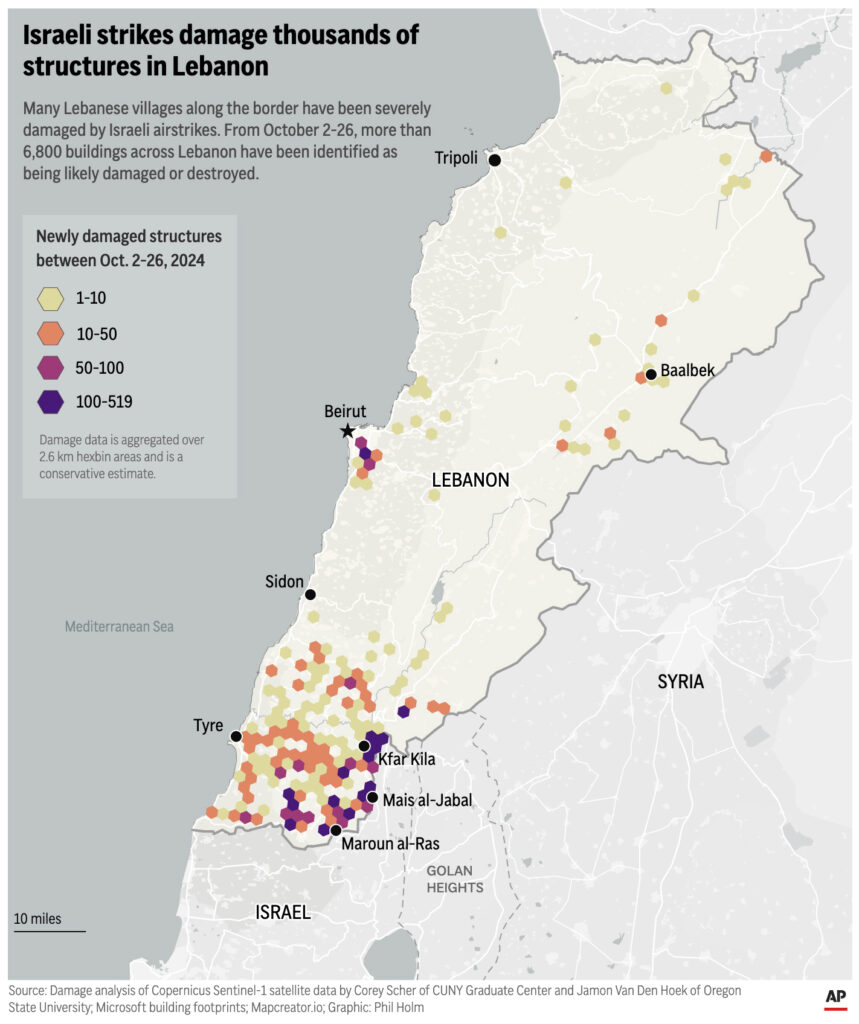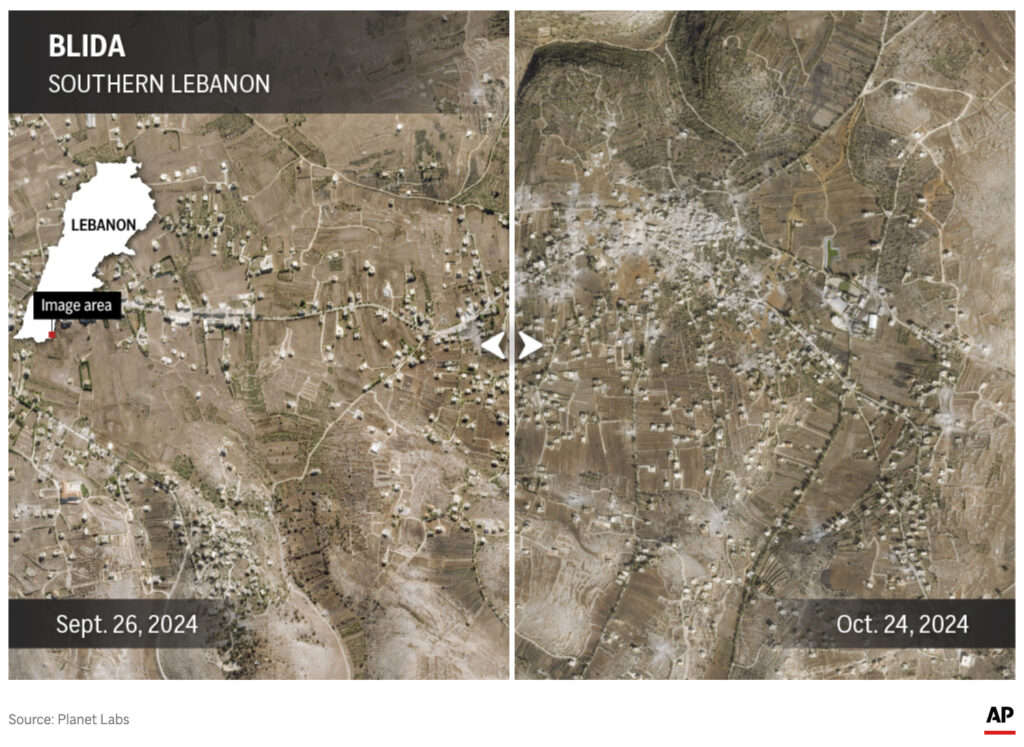Israel Lebanon buffer zone/ Israel southern Lebanon offensive/ Hezbollah Israel conflict/ UN peacekeepers Lebanon/ Lebanon displacement crisis/ Newslooks/ JERUSALEM/ J. Mansour/ Morning Edition/ Israel’s ongoing destruction across southern Lebanon has raised fears of a potential buffer zone as Israeli forces target Hezbollah strongholds near the border. Satellite images reveal severe damage across multiple villages, and with over a million people displaced, some experts believe Israel may be aiming to create a depopulated buffer area as it has in Gaza.

Israel’s Destruction in Southern Lebanon Sparks Buffer Zone Fears: Quick Looks
- Conflict Area: Israel has devastated several Lebanese villages close to the border to push Hezbollah back.
- Displacement: Over one million residents have fled from bombardments in southern Lebanon.
- UN and Army Attacks: Israeli strikes have hit U.N. peacekeepers and Lebanese army positions.
- Resolution 1701: International efforts focus on enforcing the 2006 ceasefire resolution, aiming for peace.
- Potential Buffer Zone: Experts warn Israel’s tactics may lead to an unintentional long-term buffer zone.
Israel’s Southern Lebanon Assault Raises Fears of Long-Term Occupation
Deep Look
In recent weeks, Israel’s intensified military campaign across southern Lebanon has raised fears that a de facto buffer zone may be forming along its northern border, much like the restricted zones Israel has imposed near Gaza. The tiny Lebanese village of Ramyah, perched close to the Israeli border, has nearly disappeared under bombardment, with satellite imagery showing a swath of destruction across at least 11 villages within a few miles of Israel. Israel states that these attacks are aimed at dismantling Hezbollah’s military infrastructure embedded within these towns and forcing the militant group further from the border.
The ongoing destruction has led to massive displacement, with over a million people fleeing their homes. Some analysts worry that the scale of the bombardment could signal Israel’s intent to establish a depopulated buffer zone in southern Lebanon. This tactic mirrors the approach taken along Israel’s border with Gaza, where such zones are intended to reduce militant attacks on Israeli territory.
The damage inflicted on southern Lebanon has been significant. Analysis by the Associated Press, using satellite imagery from Planet Labs PBC, shows severe destruction in villages like Ramyah and Aita al-Shaab. These areas, home to strong Hezbollah presences, have suffered widespread destruction as Israeli forces push in, destroying hundreds of buildings. The precision strikes often target Hezbollah-occupied structures, but entire neighborhoods, and sometimes whole villages, have been reduced to rubble in the process. In Odeissah, an Israeli detonation was so powerful it triggered earthquake alerts in Israel.
While Israel denies creating a buffer zone, security experts note that it could become a reality if Hezbollah remains a threat. Orna Mizrahi, a senior researcher at Israel’s Institute for National Security Studies, commented, “Israel’s immediate aim isn’t to create a buffer zone, but circumstances could lead to one if Hezbollah remains entrenched.”
Israel’s recent strikes have also targeted U.N. peacekeeping forces (UNIFIL) and Lebanese military positions, forces that international law recognizes as stabilizers in the region. Since September, UNIFIL has recorded at least 30 incidents where its personnel and infrastructure were affected, with at least seven incidents reportedly being deliberate strikes by Israel. This includes strikes on Lebanese military positions that have killed 11 soldiers. Prime Minister Benjamin Netanyahu has called for UNIFIL to leave the region, though the U.N. peacekeeping mission insists it will stay. Analysts warn, however, that this resolve may wane if peacekeepers face mounting casualties.
For decades, Israel has expressed dissatisfaction with the effectiveness of UNIFIL and the Lebanese military in preventing Hezbollah’s buildup in southern Lebanon. This sentiment has been amplified by repeated cross-border attacks from Hezbollah. Israel’s frequent air and ground operations have emphasized its demand for stricter border security, though international bodies continue to negotiate a diplomatic solution.
With Israeli forces advancing across the border, October 2024 has become one of the deadliest months in recent years for Israeli soldiers, with around 60 casualties reported so far. Israel’s deployment of flags on Lebanese soil in videos shared by the military and on social media further heightens fears of a territorial shift, although Israeli troops typically withdraw after skirmishes.
The potential establishment of a buffer zone ties back to the unresolved elements of U.N. Resolution 1701, which sought to end the 2006 Israel-Hezbollah conflict. The resolution mandated a Lebanese-controlled border zone, with U.N. peacekeepers monitoring and limiting Hezbollah’s access. However, the resolution has never been fully implemented. Hezbollah has maintained its presence along the border, and Lebanon alleges that Israel continues to occupy portions of its land while carrying out routine air patrols.
As the U.S. pushes for diplomatic efforts to reinforce Resolution 1701, there are indications that Israel’s actions may be a strategy to pressure the international community and Lebanon into a ceasefire favorable to Israeli interests. Israeli journalist Yossi Yehoshua has suggested that Israel’s military objectives aim to ensure Hezbollah, Lebanon, and mediating countries accept a favorable end to the conflict.
Many Lebanese fear that Israel’s tactics may lead to a prolonged occupation, as they did during the years following Israel’s initial invasion of southern Lebanon. Mark Daou, a Lebanese parliamentarian critical of both Hezbollah and Israel, expressed concern that Israel’s attacks could alienate the Lebanese public from supporting resistance movements, making them reluctant to defend their territory. Meanwhile, Richard Gowan of the International Crisis Group warned that Israel’s tactics may unintentionally legitimize Hezbollah as the south’s defender, undermining Lebanese and U.N. forces’ credibility as peacekeepers.
While Israel’s strategy unfolds, uncertainty looms over the long-term impact on southern Lebanon. For now, Israel’s intense military operations continue to reshape the region, displacing families, devastating towns, and straining international peacekeeping efforts. The evolving conflict underscores the fragile balance between military actions and diplomatic measures as the region braces for further developments.







